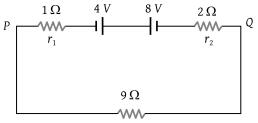The current in the arm \(CD\) of the circuit will be:

1. \(i_{1} + i_{2}\)
2. \(i_{2} + i_{3}\)
3. \(i_{1} + i_{3}\)
4. \(i_{1} - i_{2} + i_{3}\)

Two non-ideal identical batteries are connected in parallel. Consider the following statements :
(i) The equivalent e.m.f. is smaller than either of the two e.m.f.s
(ii) The equivalent internal resistance is smaller than either of the two internal resistances
1. Both (i) and (ii) are correct
2. (i) is correct but (ii) is wrong
3. (ii) is correct but (i) is wrong
4. Both (i) and (ii) are wrong
Consider the circuit shown in the figure below. The current \(I_3\) is equal to:
1. \(5\) A
2. \(3\) A
3. \(-3\) A
4. \(\frac{-5}{6}\) A
If in the given figure, then resistance X will be:
1. 5 Ω
2. 10 Ω
3. 15 Ω
4. 20 Ω
The number of dry cells, each of e.m.f. 1.5 volt and internal resistance 0.5 ohm that must be joined in series with a resistance of 20 ohms, so as to send a current of 0.6 amperes through the circuit is
1. 2
2. 8
3. 10
4. 12
For driving a current of 2 A for 6 minutes in a circuit, 1000 J of work is to be done. The e.m.f. of the source in the circuit is
1. 1.38 V
2. 1.68 V
3. 2.04 V
4. 3.10 V
Two batteries of e.m.f. 4V and 8 V with internal resistances 1 Ω and 2 Ω are connected in a circuit with a resistance of 9 Ω as shown in figure. The current and potential difference between the points P and Q are
1.
2.
3.
4.
Four identical cells each having an electromotive force (e.m.f.) of 12V, are connected in parallel. The resultant electromotive force (e.m.f.) of the combination is :
1. 48 V
2. 12 V
3. 4 V
4. 3 V
The internal resistance of a cell of e.m.f. 12V is . It is connected across an unknown resistance. The voltage across the cell, when a current of 60 A is drawn from it, is :
1. 15 V
2. 12 V
3. 9 V
4. 6 V
The current in the given circuit is
1. 0.1 A
2. 0.2 A
3. 0.3 A
4. 0.4 A










